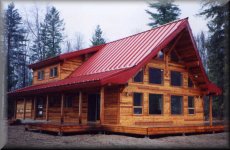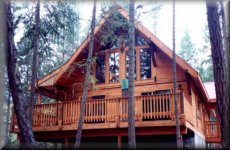






Are We Running out of Wood? |
|
We know the world's population is rapidly increasing, and that wood, as one of the earth's most versatile and available resources, is being consumed in ever-greater quantities. We also know that because it does grow back, wood is one of the most sustainable resources on the planet. It's also one of the most recyclable, environmentally friendly, inexpensive substances we use. But with the world population exploding, it's not surprising that a recent survey suggests that nearly 65 percent of Americans and Canadians fear that we are running out of wood. Fortunately, Canada has a good story to tell about its role in assuring the world's wood future. That's because a United Nations report shows that Canada's forested area is actually growing. Forest cover in Canada increased by nearly 9,000 square kilometers between 1990 and 1995, according to the UN report. In total, Canada is home to 10 percent of the world's forests. While the state of Canada's forests is one part of the picture, we still need to look at the global picture. If we are talking about the wood still in the forests, that same UN report shows that forest cover globally is actually shrinking. Despite increases in total forested area in developed countries, developing countries are losing forested area-sometimes this is called "deforestation." Deforestation refers to an area of land permanently converted from forest to other uses like agriculture or urban development. Forested area may be decreasing but again this is only one part of the answer to our question: Are we running out of wood? As you will see, innovative forest practices and production techniques mean we can increasingly get more wood from fewer trees and therefore smaller areas of forest. In terms of the world's wood market, say dimension softwood lumber, for instance, shortages do occur-and here's where we add an important qualifier-at certain times. Scarcity today can quickly become a glut tomorrow. Amidst all these variables and qualifiers a few things are certain. As the world's population grows there is likely not a wiser choice than wood for shelter, fuel, books, furniture and myriad other applications-and here we add another important qualifier. No one wants to see the complete loss of our natural global heritage in the name of products for people. But by using wood from sustainably managed forests, the needs of the world's growing population can be met in a balanced, non-destructive way. But don't take our word for it. Do your own research. Start by looking around wherever you are right now. How many items are made from wood? Could they be better made with a raw material other than wood? Then check out your library, or some of the web sites we've included in this issue of Choices. |
An exerp from the Newsletter Choices titled "A Change of Strategy" |
|
Our province is definitely not running out of wood. BC is growing more than it is harvesting, but, as forest industry consultant Don Reimer puts it, there is "a lot of that timber we can't get to. It's either in parks or protected areas, or restricted by environmental values because of increasing social pressure." Given the limitations on access to timber resources, the Forest Alliance commissioned a report to examine the issue and analyze ways of getting more from the commercial wood supply. The report centered its findings on different forestry management models for three distinct timber supply areas in the province. "We looked at various traditional approaches to increasing yield-growing trees faster, fertilization, things like that," says Reimer, one of several key consultants who contributed to the report. "You get some advantage there, but not a huge bang." The report also examined databases for growth in second generation forests a factor that had been traditionally under estimated and concluded that improving them would result in higher harvesting rates. (The BC Ministry of Forests has since increased its estimates of growth rates in regenerated forests by up to 30 percent.) But, Reimer feels, the report's key finding is this: the forest industry and the province will likely get the "biggest bang" from a new approach to forest management called habitat management. "This is a non traditional approach, and it asks, what if we change our management strategy? Instead of drawing lines on the ground and zoning areas relative to commercial timber productivity this area for aesthetics, that area for old growth under a habitat management approach, the whole forest works for you for a variety of purposes, to produce habitat, maintain riparian zones, plus recreation areas, plus viewshed, plus timber. In the US, this approach has been used to great advantage for all concerned." The province of Manitoba has also incorporated a habitat management approach into its 20 year forestry plan. "BC needs to get out of the box," says Reimer. "The commercial land base is not going to get bigger. If anything, there is going to be even more social pressure because of environmental and aesthetic needs. We need a land management strategy that doesn't focus only on defining commercial areas, but instead puts the dynamics of the entire forest base to work for you." |